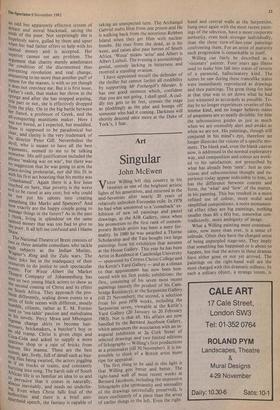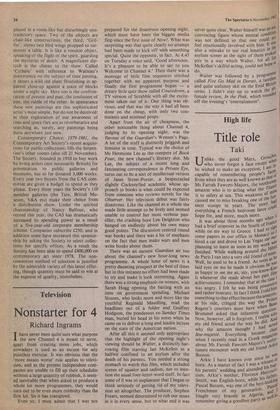Art
Singular
John McEwen
'Victor Willing left this, country in his V twenties as one of the brightest artistic lights of his generation, and returned in the mid-Seventies after nearly 20 years of relatively unbroken European exile. In 1978 he had what amounted to a 'comeback' ex- hibition of new oil paintings and pastel drawings, at the AIR Gallery, since when his promotion to the first rank of contem- porary British artists has been a mere for- mality. In 1980 he was awarded a Thorne Scholarship and the Tate bought two large paintings from his exhibition that autumn at the House Gallery. This year he has been Artist in Residence at Cambridge University — sponsored by Corpus Christi College and the Kettle's Yard Gallery — and as a climax to that appointment has now been hon- oured with his first public exhibitions: the first, consisting of his seven most recent paintings (mostly the product of his Cam- bridge Residency), at the Serpentine Gallery (till 21 November); the second, a selection from his post-1978 works, including the Serpentine seven, viewable at the Kettle's Yard Gallery (20 January to 20 February 1983). Nor is that all. His affairs are now handled by the Bernard Jacobson Gallery, which announces the association with an in- augural exhibition at 2a Cork Street of selected drawings and two limited editions of lithographs — Willing's first productions as a printmaker (till 30 November). It is im- possible to think of a British artist more ripe for appraisal.
The first thing to be said in this light is that Willing gets better and better. The right-hand wall of most recent works at Bernard Jacobson, including the impressive lithographs (the spontaneity and sensuality of the drawings successfully preserved), is more confidently of a piece than the array of earlier things to the left. Even the right-
hand and central walls at the Serpentine, hung once again with the most recent paint- ings of the selection, have a more corporate authority, even look stronger individually, than the three turn-of-last-year paintings confronting them. For an artist of maturity such progression is remarkable in itself.
Willing can fairly be described as a 'visionary' painter. Four years ago illness used to make him fall into states of reverie of a paranoid, hallucinatory kind. The scenes he saw during these trancelike states were immediately reproduced as drawings and then paintings. The great thing for him at that time was to set down what he had' just witnessed as accurately as possible. To- day he no longer experiences reveries of this intense kind, and no longer believes states of awareness are so neatly divisible: for him the subconscious guides us just as much when we are ostensibly alert and awake as when we are not. His paintings, though still conjured in his mind's eye, therefore no longer illustrate the visions of a specific mo- ment. The blank pad, even the blank canvas now, is addressed in the normal exploratory way, and composition and colour are work- ed to his satisfaction, not prescribed by what has already been 'seen'. Just as con- scious and subsconscious thought and ex- perience today appear indivisible to him, so has the difference between content and form, the 'what' and 'how' of the matter, in his painting. This has resulted in a more refined use of colour, more stolid and simplified compositions, a more monumen- tal effect (they are big paintings, nothing smaller than 8ft x 6ft) but, somewhat con- tradictorily, more ambiguity of image.
What a Willing painting most communi- cates, now nuke than ever, is a sense of solitude. Often they have the charged sense of being unpeopled stage-sets. They imply that something has happened or is about to happen, but that the actors in these dramas have either gone or not yet arrived. The paintings on the right-hand wall are the most charged with this dramatic stillness. In each a solitary object, a strange totem, is placed in a room-like but disturbingly con- tradictory space. Two of the objects are chair-like constructions, the third, 'Grif- fin', shows two bird wings propped to sur- mount a table. It is like a voodoo object, speaking of the flight of the spirit, guarding the mysteries of death. A magnificent dip- tych is the climax to the show. Called 'Cythere' with reference to Watteau's masterpiece on the subject of time passing, it shows a wild red plant flourishing in ap- parent close-up against a maze of blocks under a night sky. Here too is the confron- tation of present and past, the confusion of one, the riddle of the other. In appearance these new paintings are this sophisticated artist's most simple, but do not be deceived: in their exploration of our awareness of time and space they are as reverberative and searching as, surely, any paintings being done anywhere just now.
Contemporary Choice, 1979-1981, the Contemporary Art Society's recent acquisi- tions for public collections, fills the Serpen- tine's other rooms (also till 21 November). The Society, founded in 1910 to buy work by living artists (not necessarily British) for presentation to public galleries and museums, has so far donated 3,000 works. Every year two buyers from the CAS com- mittee are given a budget to spend as they please. Every three years the Society's 110 member galleries (the Tate, British Mu- seum, V&A etc) make their choice from a distribution show. Under the spirited chairmanship of Nancy Balfour, who retired this year, the CAS has dramatically increased its spending power as a result of a five-year-old corporate membership scheme. Companies subscribe £250, and in addition some have increased this sponsor- ship by asking the Society to select collec- tions for specific offices. As a result the Society has been able to spend £800,000 on contemporary art since 1978. The non- committee method of selection is justified by the admirable variety of this latest offer- ing, though quantity must be said to win at the expense of quality, nonetheless.















































 Previous page
Previous page